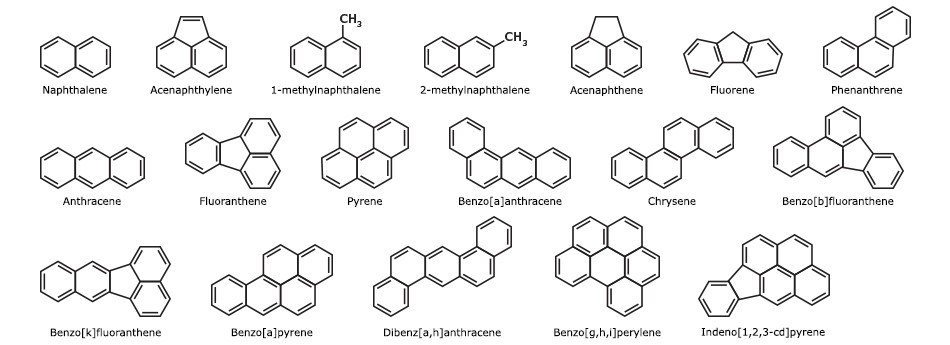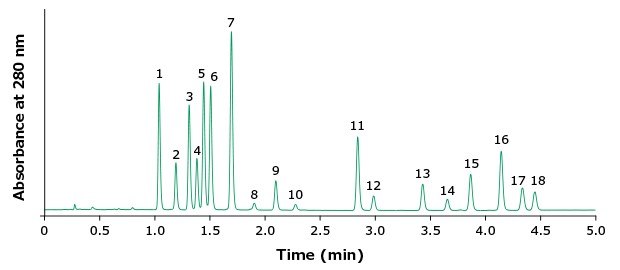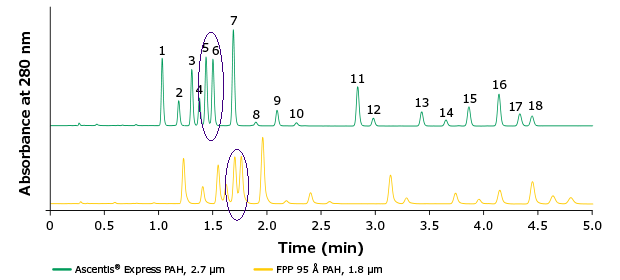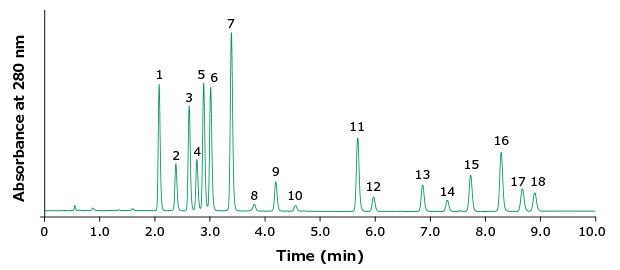Fast Separation of 18 PAHs with Ascentis® Express
Petra Lewits, Global Product Manager for HPLC Columns
Article from Analytix Reporter - Issue 15
Introduction
Polycyclic aromatic hydrocarbons (PAHs) are toxic compounds commonly found in the environment because of incomplete combustion of fuels, such as coal, tar, and crude oil, among others. These compounds’ carcinogenic, mutagenic, and teratogenic nature makes them compounds of concern to environmental organizations around the world. Consequently, there are many regulatory methods in place for PAH testing in environmental samples like air, soil, water, as well as food samples to protect human health.
PAH analysis in water at trace levels demands a highly sensitive method. In this application, we demonstrate an analysis for the separation of 16 + 2 standard PAH compounds (Figure 1) mentioned in EPA method 610 and 8310 on an AscentisR Express PAH column.
The Ascentis® Express PAH is a non-endcapped, trifunctional C18 phase with a proprietary manufacturing process, designed on superficially porous particle (SPP) technology, to provide a fast and efficient separation of PAH compounds. The analysis was completed with a resolution value of at least 1.5 in under 5 minutes for EPA method 610. The column gave better detection sensitivity with fluorescence detection in comparison to UV and a fully porous particle (FPP) sub-2 μm column.

Figure 1. 16 EPA 610 & 8310 + 2 PAH compound structures
Experimental
Here a separation under 5 min for the 16 PAHs in EPA 610 plus 1-methylnapthalene and 2-methylnaphthalene is shown using a 5 cm x 4.6 mm column (Table 1) & is shown (Figure 2).
Separation of 18 PAHs: EPA 610 with UV detection

Figure 2.HPLC Separation of 18 PAHs with UV detection (peak ID see Table 2).
Separation of 18 PAHs: UV and Fluorescence detection (FLD)
For this comparison of an FLD to a UV method, the chromatographic conditions were the same as for the above shown UV detection (Table 1), except for the changed injection volume of 0.3 µL. The chosen FLD settings Ex: 260/ Em: 350/440/500.

Figure 3. Separation of 18 PAHs with fluorescence and UV detection (peak ID see Table 2).
FPP vs. SPP: Comparison for PAH Analysis using EPA 8310 + 2 method
Comparison of the superficially porous particle (SPP) Ascentis® Express PAH column to a fully porous particle column (FFP) in the market, both 5 cm x 4.6 mm I.D. under the conditions outlined in Table 3 is shown in Figure 4.
The Ascentis® Express PAH outperforms a fully porous particle (FPP) sub-2 μm column for a fast, 5 min separation of EPA method 8310 + 2 compounds demonstrating improved speed and resolution (Figure 4).

Figure 4.Comparison of Ascentis® Express PAH (green) and fully porous particle (FPP) sub-2 μm column (yellow) for a fast, 5 min separation of method EPA 8310 + 2 PAHs (Peak IDs see Table 2).
Highly Efficient Separation of 18 PAHs on a 3 mm I.D. Column
A column with 3 mm ID was used for the separation shown in Figure 5 with the conditions described in Table 4. This dimension provided more LC-MS suitability and higher sensitivity of the method.

Figure 5.Fast and sensitive separation of 18 PAHs on Ascentis® Express 90 Å PAH, 2.7 μm, 10 cm x 3.0 mm I.D (peak IDs see Table 2).
Conclusion
The Ascentis® Express PAH column delivers a method-specific, robust, and high-efficiency separation of 16 + 2 standard PAH compounds with a resolution value of at least 1.5 in under 5 minutes for EPA 8310. Using a fluorescence detector, the method’s sensitivity increases substantially in comparison to UV detection.
The Ascentis® Express PAH outperforms a fully porous particle (FPP) sub-2 μm column for a fast, 5 min separation of method EPA 8310+2 demonstrating improved speed and resolution. A 3 mm I.D. HPLC column enables more results, suitability for LC-MS use, and solvent savings.
Related Products
Related Reference Materials
To continue reading please sign in or create an account.
Don't Have An Account?